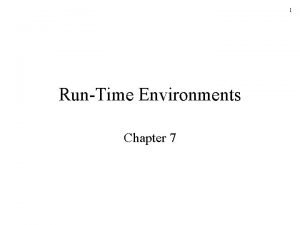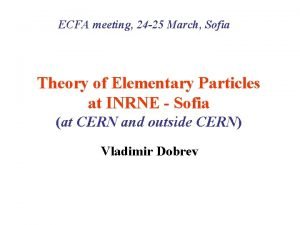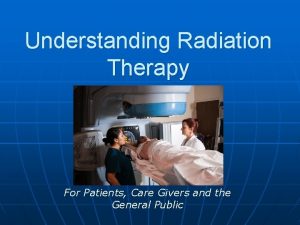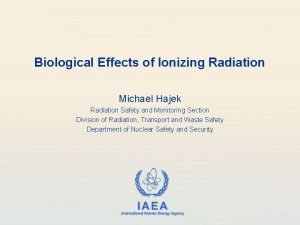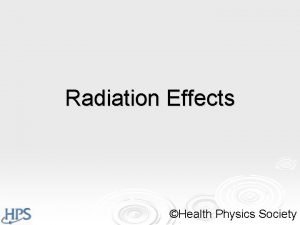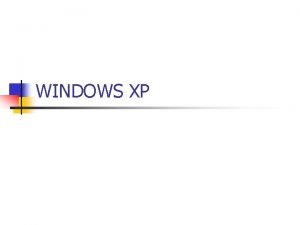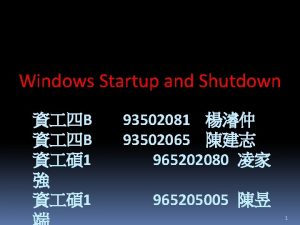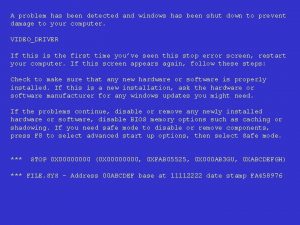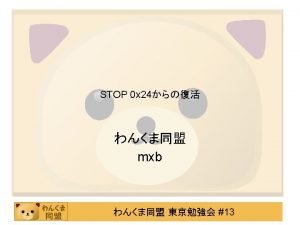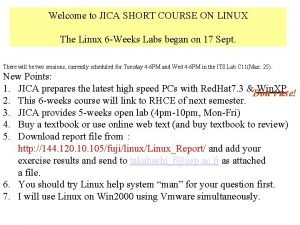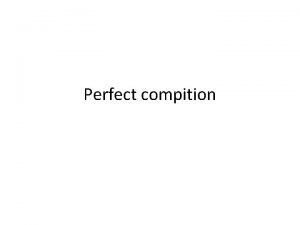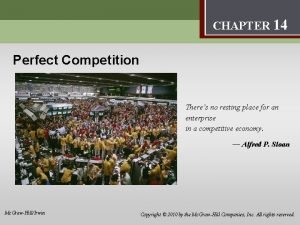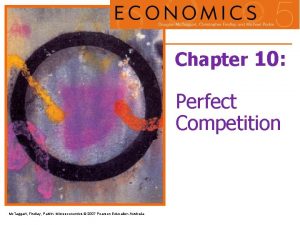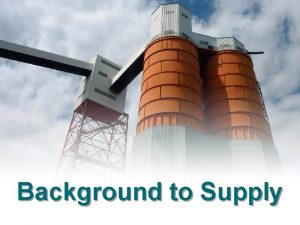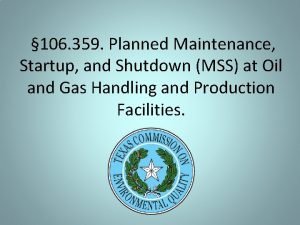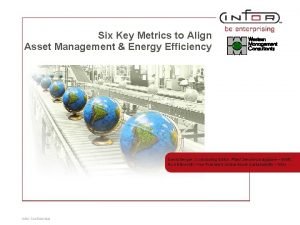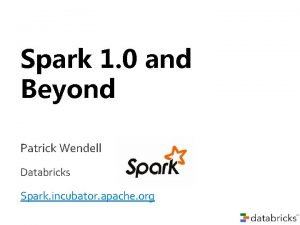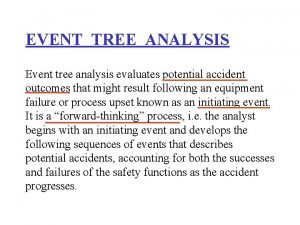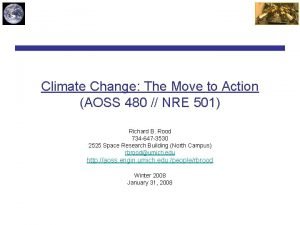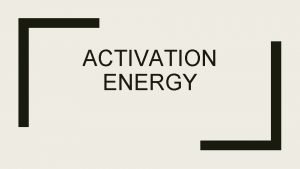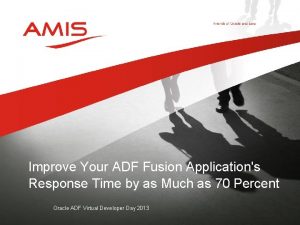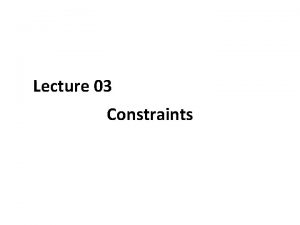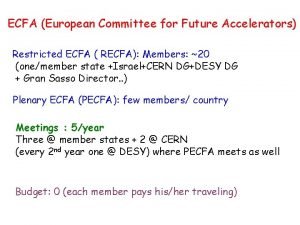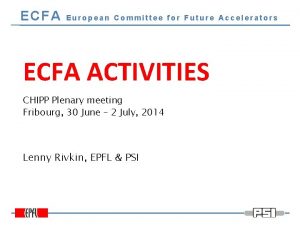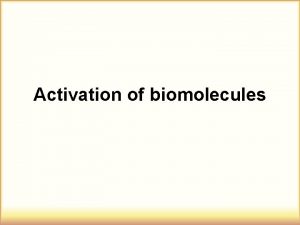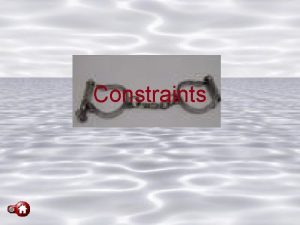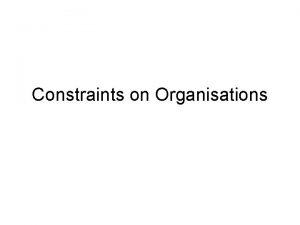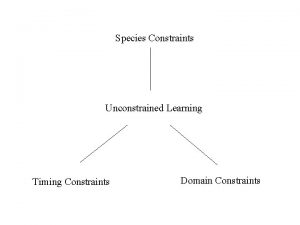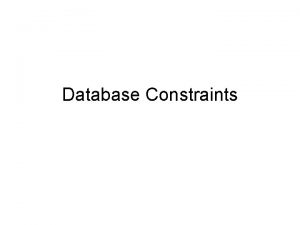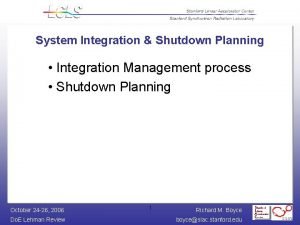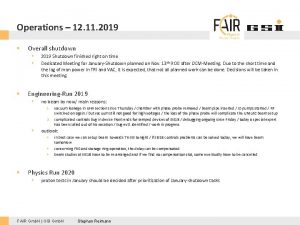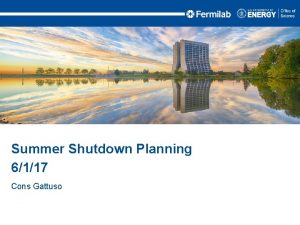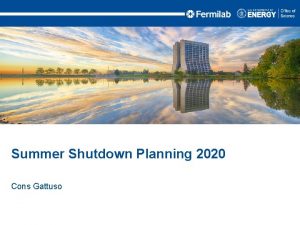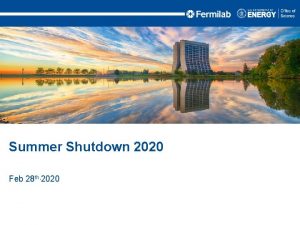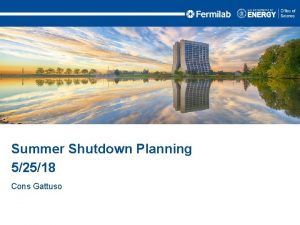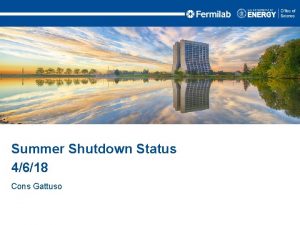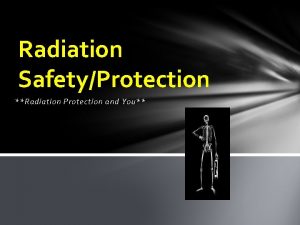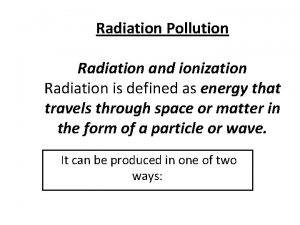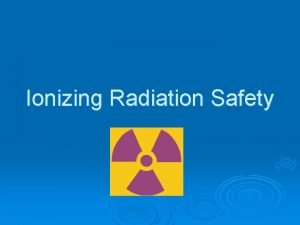Shutdown Constraints and Radiation and Activation effects ECFA


























- Slides: 26

Shutdown Constraints and Radiation and Activation effects ECFA - Aix Les Bains 02. 10. 2013 O. Beltramello, H. Vincke, G. Corti on behalf of the Working Group

The first step. . . Understand the amplitude of the radiations problem due to material activation. . . 1. Scale factor between the doses measured at LS 1 and LS 3/LS 4/LS 5 shutdowns. . . Estimations were performed using the present detectors configuration and two different assumptions of luminosity profile (from 2011/2012): ATLAS (minimum target lumi) CMS (optimistic * 1. 5) After LS 3: ATLAS detector current configuration 5. 1034 peak luminosity per year 300 fb‐ 1 integrated luminosity per year Total integrated luminosity in 2036 ≈ 3000 fb‐ 1

Estimation of scaling factors (H. Vincke, S. Roesler, C. Urscheler, K. Zabrzycki) In general : Short cooling times are dominated by short-lived radio nuclides dose rate reflects the interaction rate (peak luminosity) Long cooling times are dominated by longer-lived radio nuclides dose rate reflects roughly the integrated luminosity For both cases, it depends strongly on the material and therefore on the produced radionuclides Between LS 1 and LS 2 / LS 3 shutdowns – cooling time 4 months: For a longer cooling time, the scaling factor is increasing

Between LS 1 and LS 4 / LS 5 shutdowns : New calculations performed recently (H. Vincke, K. Zabrzycki, C. Strabel) ATLAS detector current configuration

TAS Barrel cal. / End Cap Cal. I/F 4 weeks 250 m. Sv/h 1 year

Inner Detector region: Scaling factor between 25 to 40 The scaling factor increases for long‐lived radio nuclides.

TAS region: Scaling factor between 25 to 35 The scaling factor increases for long‐lived radio nuclides.

ECT ‐ TAS side C, 21‐Feb‐ 2013 Distance from Beam Pipe: Contact, 20 cm, 40 cm, 1 m, 2 m Measurements in m. Sv/h ATLAS – LS 4 estimation ≈2 months cooling scaling factor (LS 4/LS 1): 30 RP - Conan Nadine; RPE – Spigo Giancarlo LS 1 measurements 75 m. Sv/h 1. 4 m. Sv/h 150 m. Sv/h LS 4 estimation 300 m. Sv/h

SW/JD ‐ EBC side C, ATLAS – LS 4 estimation 8‐Mar‐ 2013 SW/JD(open), EBA (open) , VA (steel), VT (removed) Distance from Beam-pipe: Contact, 10 cm, 20 cm, 40 cm, 1 m, 2 m Measurements in m. Sv/h ≈2 months cooling scaling factor (LS 4/LS 1): 30 RPE – Spigo Giancarlo LS 1 measurements 11130 (SW/JD open) 9840 (EBC) 34 29 25 39 26 22 144 150 23 310 116 47 18 18 14 21 4 4. 5 7 50 cm 30 cm 1. 7 1. 2 4 m. Sv/h EBC 600 m. Sv/h 135 m. Sv/h SW 1. 3 LS 4 estimation 20 cm 1. 4 Contact

Barrel Calo – EBA side A , 11‐Mar‐ 2013 ATLAS – LS 4 estimation ECAL(open), VA(steel) Distance from Beam Pipe: Contact, 10 cm, 20 cm, 40 cm, 1 m, 2 m Measurements in m. Sv/h ≈2 months cooling scaling factor (LS 4/LS 1): 30 RP: Nadine Conan, RPE: Giancarlo Spigo 40 cm 90 cm 70 cm 40 cm 70 cm 3650 (VI) VA 6680 (EBA) EBA 90 35 112 42 75 24 53 27 55 22 20 20 12. 5 15 21 15 12 10. 5 11 19 9 5 3. 5 6. 5 4. 5 LS 1 measurements 2. 5 3. 1 m LS 4 estimation 300 m. Sv/h 900 m. Sv/h 2. 5 VI Barrel

CMS – LS 1 Radiation Dose Rate 20 Feb 2013 DGS/RP + CMS RPE MEASUREMENT Values (Contact, 40 cm, 1 m) are in u. Sv/h 2 3 5 16 4 40 18 38 16 38 34 42 140 85 140 1500 CMS – LS 4 Estimates About 2 months cooling time LS 1/LS 4 Scaling Factor of 30 550 Rotating Shielding Open 25 Feb 2013 DGS/RP + CMS RPE 3 3 8 13 13 14 14 74 82 45 58 85 45 m. Sv/h 1. 3 m. Sv/h 480 u. Sv/h 90 u. Sv/h Forward Detector on 2 risers

ALICE : The HI program for Run 3 and Run 4 foresees a delivered Pb. Pb luminosity of >10 nb -1. The radiation load of 10 nb-1 of Pb. Pb collisions @5. 5 Te. V/nn corresponds to the radiation load of <100 pb-1 of pp collisions@14 Te. V. Activation is a small issue for a few elements very close to the beampipe in ALICE. LHCb : 2011 2012 Ebeam (Te. V) 3. 5 Lint (fb-1) Lave (cm 2 s-1) 2015 2016 2017 4 6. 5 1. 2 2. 2 1. 5 3. 6× 103 4× 1032 4× 103 2 LS 1 2 LS 2 2019 2020 2021 6. 5 7 7 7 1. 5 2. 0 5 5 5 4× 1032 6× 1032 1× 1033 2× 1033 LS 3 New calculations are being carried out for LS 2 when major LHCb detector upgrade will take place. If needed, access close to the beam pipe in the area of the VErtex LOcator is possible very shortly after beam dump, hence it is important for LHCb to also consider activation after short cool down times. Based on measurement done in 2012, simple scaling for energy and luminosity expect ~230 u. Sv/h at 40 cm from beam pipe after 2‐ 3 h for Run 3 (the same after LS 3).

3. Reminder of the CERN regulations and strategy: CERN regulation – Safety code F ✓ Any practice leading to an effective dose exceeding 100µSv per year for individuals working on the CERN site or 10µSv for members of the general public must be justified. ✓ It is obligatory to optimize radiation protection according to the As Low As Reasonably Achievable (ALARA) principle. Optimization can be considered as respected if the annual dose of a practice is below 100µSv for persons exposed because of their professional activity and 10µSv for members of the general public. ✓ The effective dose in any consecutive 12 -months period is limited to: • 20 m. Sv = Category A Radiation Workers • 6 m. Sv = Category B Radiation Workers • 1 m. Sv for not occupationally exposed personnel (the effective annual dose to any person outside of the CERN site boundaries must not exceed 300µSv). And. . . we must declare to Swiss Federal Office of Public Health if one person exceed 2 m. Sv/ month !

Design constraints for new or upgraded facilities (HILUMI LHC ‐ CERN‐ACC‐ 2013‐ 018 ‐ S. Roesler – Nov. 2012 and in Chamonix Workshop 2005) The exposure of persons working on the CERN sites, the public and the environment will remain below the dose limits under normal as well as abnormal conditions of operation and that the optimization principle is implemented. In particular, the following design constraints apply: Design of new components and equipment must be optimized such that installation, maintenance, repair and dismantling work does not lead to an effective dose exceeding 2 m. Sv person and per intervention. The design is to be revised if the dose estimate exceeds this value for cooling times compatible with operational scenarios. Selection of construction material must consider activation properties to optimize dose to personnel and to minimize the production of radioactive waste. The web-based code Acti. Wiz is available for CERN accelerators

3. ALARA Strategy Optimization is a legal requirement if the accumulated dose exceeds 100 μSv (ALARA) person. Optimization includes: • design • material choice (Acti. Wiz) • work coordination • work procedures • tools • follow up ALARA Committee ALARA criteria – EDMS Group 1 criteria: determine ALARA Level classification Group 2 criteria: can be used by RP to increase (or eventually decrease) classification

ALARA Strategy The following personal dose objectives apply at CERN (for any consecutive 12 -months period) (HILUMI LHC ‐ CERN‐ACC‐ 2013‐ 018 ‐ S. Roesler – Nov. 2012) Ø Personal dose < 2 m. Sv for Winter Shutdowns and operational period Ø Personal dose < 3 m. Sv for Long shutdowns Some collected statistics - courtesy of the CERN Dosimetry Service Distribution of personal annual dose equivalent from 2005 onwards. The majority of monitored persons did not receive any personal dose. In 2012, only 29 persons exceeded an annual dose of 1 m. Sv!

Means envisage by the experiments to lower the dose rates 1. Shielding: CMS Shielding Front shielding BP shielding Back shielding Main support Ecal end cap Inner Tracker

2. Devices to supervise and assist personnel in radiation areas ATLAS Personal Supervision System ATWPSS already in use for LS 1 --Removal of VJ Beam Pipe

3. Remote Handling Manipulations We are currently investigating what are the most appropriate technologies TELEMAX MASCOT

Impact of Air Activation on Access conditions and environment. . . 1. An estimation of the activation at LS 4/LS 5 shutdowns. . . CMS, ATLAS and LHCb air activation have been calculated CERN-SC-2008 -067 -RP-TN. V 2 (2008) COOLING TIME Effective dose CMS [μSv] Effective dose LHCb [μSv] Effective dose ATLAS [μSv] 0 MIN 1. 81 0. 05[μSv 1. 46 1 H 0. 54 0. 02 0. 32 2 H 0. 43 0. 01 0. 26 6 H 0. 34 0. 01 0. 23 ½ DAY 0. 31 <<0. 01 0. 22 DAY 0. 30 <<0. 01 0. 21 CERN Guideline: effective dose due to inhalation < 1 μSv per hour of presence CMS: ~1034 cm‐ 2 s‐ 1 ~109 proton‐proton collisions per second LHCb: 2. 1032 cm‐ 2 s‐ 1 1. 6 x 107 proton‐proton collisions per second Beam energy 14 Te. V Waiting time for LS 1 is 15 min. A scaling is performed assuming proportionality with peak luminosity: After 1 day, effective dose in ATLAS and CMS ~ 1 μSv/h at 5. 1034 We need to run more accurate calculations.

Impact of Air Activation on Access conditions and environment. . . 2. Possible impact on environment and ventilation system: The consequences on environment has to be carefully analyzed and eventually modifications of the ventilation system at some LHC locations. Can we still survive with the current ventilation system ? • ATLAS , CMS – 80 % recirculation • LHCb – no recirculation For some of the experiments, the tightness between the experimental caverns, the services caverns and the LHC machine has to be consolidated Example: LHCb Velo/Tunnel : ~ -20 Pa Measurements Oct 2012 show that air Muon/Tunnel : ~ 0 Pa UXA/UXB : ~ +10 Pa activation in the tunnel upstream of LHCb is about twice that of the area of the VErtex Locator close by. For the current situation dose to personnel from air leaking into LHCb is negligible. Re-assessment for LHCb upgrade is recommended

Impact of radiations in the services caverns during Beam. . . 1. An estimation of the neutrons in the service caverns areas and surface buildings to be estimated. A first estimation is performed with a simple proportionality with the peak luminosity Example: ATLAS Ref: Radiation in the USA 15 cavern in ATLAS I. Dawson, V. Hedberg 2004 ATL-TECH-2004 -001 6 µSv/h USA 15 Service cavern ‐ Just behind the wall between UX 15 and USA 15 Dose rate due to neutrons at 1034 ≈ 6 µSv/h Dose rate due to neutrons at 5. 1034 ≈ 30 µSv/h We need to shield the UX 15/USA 15 wall to remain a supervised radiation area (we target an attenuation factor 2 to 3)

LHCb Calculation for the as-built shielding wall between the UX 85 A accessible side of the cavern and UX 85 B, where the detector sits done in 2008 for nominal LHC and nominal LHCb (C. Theis et al. , EDMS no. 847155 ). Radiation levels for UX 85 A well within a Supervised area classification when scaling to LHCb upgrade luminosity Average ambient dose equivalent 0. 56 u. Sv/h ± 2% << 15 u. Sv/h à No issues for LHCb upgrade Luminosity for normal operation. Ambient-dose-equivalent on D 3 [p. Sv/primary proton lost] Radiation levels in UX 85 A also to comply with limit of 20 m. Sv ambient-dose-equivalent in case of a full beam loss. Average dose values in counting rooms are ~4 m. Sv for a full beam loss of one 7 Te. V beam of 4. 7 x 1014 protons, BUT on 4 th floor dose levels are above 20 m. Sv (blue box) hence access is restricted. àMay be an issue with increase of beam intensity in HL‐LHC

Contamination. . . 1. Estimation of the contamination problem amplitude ü Fluid activation calculations are to be updated for the 4 experiments with the HL-LHC conditions to determine the risks of contamination and impact on environment. ü Regularly analyze contamination and follow up history to quantify the issue for the HL-LHC. Note that corrosion of metallic structure might highly increase the dust contamination 2. Possibly anticipate solutions. . . ü follow up carefully the history where possible by taking samples ü use double containers ü replace the type of fluids with less problematic ones for example C 3 F 8 by CO 2 (already on going for some fluids because of green house gases effects) 3. Determine the real impact of contamination on activities ü Required infrastructure ü Training for personnel ü Scheduling impact can be huge ü . . . and also the cost impact. . .

Material activation. . . Revision of the radioactive zoning for the 4 experiments taking into account: ü the irradiation scenario of the HL_LHC ü New detectors layout ü Exemption limits (in Bq/kg) are under revision presently in Europe and might be enforced soon (in Switzerland probably in 2015). These LE values will be sometimes significant lower then nowadays. The main dominating isotope for Copper and Stainless Steel is Mn‐ 54 for 1 month and 1 year cooling time For Mn-54, the threshold is divided by 100 ! We need to assess üthe quantity of radioactive material in the experiments ücharacterisation of radioactive waste (nuclide inventory) üan estimation of the required of cool down areas and storage space üradioactive workshops üassociated costs

Conclusions. . . ØWe have a first idea of the issues related to radiations and activation for the HL‐LHC. ØClearly we will have to face very high residual doses in CMS and ATLAS ØAir activation, contamination will probably also be an issue. ØThe radioactive waste will also increase by a significant amount. ØAssociated to this, we will have to face schedule and costs impacts. ØWe need to understand in more details where and when will appear these issues. ØSome calculations have started and need to be continued in close collaboration with the CERN RP group. ØIn parallel, LHC Experiments are investigating already ways to mitigate the radiation and activation problems for the access periods.
 Activation tree example
Activation tree example Ecfa symposium
Ecfa symposium Ecfa physics
Ecfa physics Cancer treatment
Cancer treatment Biological effects of radiation
Biological effects of radiation Effect of radiation on chromosomes
Effect of radiation on chromosomes Windows xp startup and shutdown
Windows xp startup and shutdown Windows startup and shutdown
Windows startup and shutdown Problem has been detected and windows needs to shut down
Problem has been detected and windows needs to shut down A problem has been detected and omega system
A problem has been detected and omega system Lab 8-1: working with boot loader and runlevels
Lab 8-1: working with boot loader and runlevels Economics shutdown point
Economics shutdown point Shut down point in perfect competition
Shut down point in perfect competition Shutdown point economics
Shutdown point economics Shutdown point
Shutdown point Downward sloping demand curve
Downward sloping demand curve Short run shutdown point
Short run shutdown point Internet shutdown
Internet shutdown September 7 shutdown
September 7 shutdown Shutdown maintenance examples
Shutdown maintenance examples Align assets register
Align assets register Suse linux shutdown command
Suse linux shutdown command Patrick wendell
Patrick wendell High temperature shutdown
High temperature shutdown Thermohaline shutdown
Thermohaline shutdown Determine activation energy from graph
Determine activation energy from graph Activation and passivation in adf
Activation and passivation in adf
